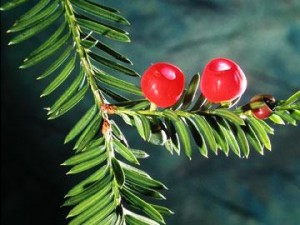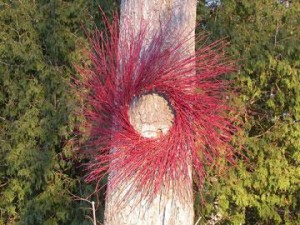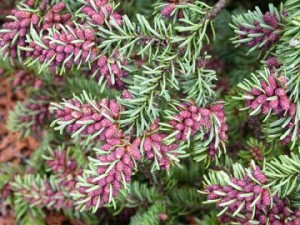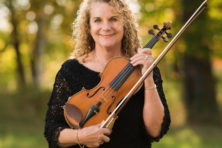Door to Nature
- Share
- Tweet
- Pin
- Share
It’s nearly Christmas, a time when nature shares its own array of sights and aromas of the season.
Surely these include the brisk, outdoor-perfumed Balsam Fir trees so common in the North Woods, their lovely spire shapes often decorated with glistening snow. Or the fallow fields overgrown with hundreds of Red Dogwood shrubs announcing their presence against a white winter background, and the rich deep green needles and brilliant red fruit-like cones of the Canada Yew.
The word fir is used by many people to denote most, if not all, evergreens whether they be fir, spruce, hemlock, juniper or pine. As you might have guessed, the Balsam Fir doesn’t even belong to the balsam family either but rather the pine family, that huge group which included the pines, larches, spruces, hemlocks and firs.
The balsam family includes entirely different plants such as the Touch-Me-Not (Spotted Jewelweed) and the popular summer flower-garden annual, the Impatiens. Another plant, the Balsam Poplar tree, shouldn’t be associated with the Balsam Fir other than that both are trees. The Balsam Poplar, or Balm of Gilead, is a member of the cottonwood tribe.
Another tree to not confuse with the Balsam Fir is the Balsa tree. Famous for its extremely light wood, being abut twice as buoyant as cork, the Balsa tree is native to a small area in El Salvador. Technically the wood of Balsam Fir weighs about 25 pounds per cubic foot, compared to between six and seven pounds per cubic foot for Balsa wood.
Cut down a Balsam fir tree, or bruise its rather thin bark, and you will soon have sticky fingers. Better yet, puncture one of the so-called pitch blisters on the trunk and enjoy its heady Christmassy odor. For years this oleoresin, referred to as Canada balsam or Canada turpentine, was used to glue camera lens elements together or as a fixative in preparing microscope slides. This amazing material has the same refraction index as optical glass.
One of the most wonderful and memorable experiences I’ve ever had with the exhilarating perfume of the Balsam Fir tree occurred on a nature hike I was leading during my early years at The Ridges Sanctuary in Baileys Harbor, around 1967. For the first time, one of the members of my group was a totally blind young lady. Suddenly my style of interpretation had to change in order to not ignore the sightless lady. Now, rather than my uttering, “Do you see this, or notice the shape and color of this plant,” I did my best to include as many hands-on experiences as I could using the other senses.
One of the first things I thought of doing as we began our hike was to cut a foot-and-a-half-long bough of Balsam Fir and instruct each person to briskly rub the bough between their hands in order to get the full odor of the needles. When all were finished enjoying the treat, my blind friend asked if she could carry the bough. Practically every time I faced my group during the remainder of the tour, there she was vigorously rubbing the Balsam Fir branch, then holding it to her nose as she inhaled its fragrance.
Even though Balsam Firs are native to the northern three-fifths of Wisconsin they are very fussy growers at best. They don’t tolerate polluted air, are sensitive to drought, and need cool constant soil moisture for their best growth. The dozen or so rather small Balsam Fir trees growing in our upper woods are doing poorly due in part to the several recent consecutive dry summers. Enjoy these trees in the wild. Generally they are not considered good ornamental plants.
Factors that help make them such ideal Christmas trees are their rich green foliage, blunt round-tipped needles that are soft to the touch, and their remaining on the tree even after some drying occurs. Obviously they do best when watered regularly. Our Christmas tree this year, as usual a Balsam Fir, was plantation-grown in Door County and Charlotte waters it every morning.
In the wild they favor a cold climate and well-drained but moist soil. They are extremely tolerant of shade in early age, grow rapidly (seldom more than 150 years) and have a shallow root system. The largest in Wisconsin, growing in Oneida County, is around five and one-half feet in circumference and 80 feet tall. Our nation’s champion, growing in Fairfield, PA, is over 12 and one-half feet in circumference and towers 104 feet.
The flat needles which adhere to the twigs with little round sucker pads are about one inch long, shiny above and dull below due to a build-up of wax, and are known to remain on the tree for five to eight years before they drop. One of the interesting things we’ve done in past years with the needles of our Christmas tree, before recycling it to nature, was strip off many of the needles and stuff small muslin bags with them. Several sit on top of the back-rest cushions of our living room sofa, still retaining their nice perfume after several years. Occasionally we like to toss a small handful on the hot cooking surface of our fired-up kitchen wood range. Quickly they spin around and, as they cook, exude their delightful Christmassy odor, quickly perfuming the entire house. By the way, you can accomplish the same thing by using an old cast iron frying pan in which to heat the needles.
One of the most Christmas-like color combinations in nature which we photographed in recent years were the reddish male pollen-bearing flowers, or cones, on Balsam Fir trees. These very small colorful cones are always near the bottom of the tree while the larger, female, seed-bearing cones are near the top of the tree.
In the North Country, Balsam Fir is a favorite winter browse of the Moose. Even though it is heavily eaten in northern Wisconsin by a lot of White-tailed Deer it is considered a starvation food at best. Deer cannot survive at all when restricted to a diet of Balsam Fir and White Spruce.
In my estimation, as well as that of many others, the use of real Christmas trees is a wise conservation practice. Being renewable natural resources they can be easily grown and are a great boon to our winter economy.
As Donald Culross Peattie, famous nature writer, wrote, the Balsam Fir tree is “…breathing of all out of doors and cupping healthy North Woods cold between its boughs, to bring delight to human children (and adults)!”
Have a wonderful and memorable Christmas and a Happy New Year in which you dedicate yourself to becoming a true Partner In Nature.







